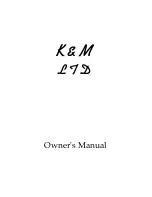
GENERAL INFORMATION
SAFETY INTERLOCK
While the Amplifier's top cover is in place, the interlock switch
closes to allow AC line voltage to reach the power transformer.
When the top cover is removed, the interlock opens and
disconnects the line voltage. This does not discharge the bank
of power supply filter capacitors. Be sure to allow the filter
capacitors to discharge before you touch anything inside the
Amplifier. You can select the High Voltage function of the
Multimeter to check the high voltage potential. Never attempt to
defeat the safety interlock.
WARNING- Never remove the cover
of this amplifier with the unit plugged into the power line.
mal continuous amateur operation at 1500 watt levels. Power is
applied through RLY2 when the 12V DC low voltage supply is
activated. A 10 ohm resistor limits the line current during the
filter capacitor charge time to lower the stress on components.
When the primary voltage approahces the full line value, RLY3
shorts the 10 ohm resistor and applies the full line voltage to the
plate transformer. The 10 ohm resistor acts as a fuse during
start-up if the high voltage supply has a short.
TIMER OVERLOAD BOARD
DRIVING POWER
This Amplifier is designed to operate at full ratings when it is
driven by an exciter that has approximately 65 watts of RF
output. You can use an exciter that has lower output power, but
the Amplifier's output will be less. If you use an exciter that
delivers more than 100 watts, carefully adjust the driving power
to avoid "over drive" and the creation of spurious signals, which
create needless interference to other operators. We highly
recommend that you use a monitor scope for continuous output
monitoring. The display on an oscilloscope is the best way of
determining the amplitude of the voice peaks which, if
excessive. can cause "flat topping" and splatter. This amplifier
has a circuit that protects the tube from excessive grid current. If
175 mA of peak grid current is reached, the "OPR" LED will no
longer light and the amplifier will go into a bypass condition.
This overload condition can be reset by momentarily putting the
STBY/OPR switch in the STBY position.
IMPORTANT: In no case should you advance the power output
control of your exciter beyond the point where the Amplifier's
Power Output indication ceases to increase. If you turn the
control past this point, nonlinear operation may occur.
FILAMENT SUPPLY
The filament circuit of this amplifier satisfies all requirements
of the tube manufacturer related to tube performance and life.
Inrush current is controlled by the transformer internal
resistance and impedance, filament choke resistance and
filament wiring resistance. To insure maximum life of the tube
never replace any circuit components or wiring with substitute
parts.
The AL-1500 has a circuit board mounted on the front panel
side of the filter capacitor board that provides time delay to
insure the cathode of the 3CX1500A7/8877 has reached proper
operating temperature before high voltage and RF drive power
can be applied. This board also samples the peak grid current
and removes drive if the grid current is excessive.
The timer portion if this circuit board uses IC1A as a com-
parator to drive the complimentary darlington 01 and 02. When
twelve (12) volts is first applied to terminal "Y" diode D3
provides a regulated 5.1 volt reference. Divider R8 and R7
reduces the reference voltage to 3.7 volts. C9 charges from
current supplied by R9. After approximately three minutes, the
comparator output (pin 1) goes high. Q3's collector goes low
and turns on Q2 and Q1. If the 12 volt supp!y is momentarily
interrupted diode D1 discharges C9 through R6, R7, and R8.
Any interruption of more than a few seconds requires a
complete timing cycle to begin again.
The grid overload circuit compares the voltage developed
across the grid shunt (.3V equals 200mA) to the .256V reference
provided by R5 and R11. This sets the grid trip at 175 mA. Pin 7
of IC 18 will go high and turn 04 on if the grid current reaches
175 mA. This will cause RLY 1 to latch on and remove the 12
volts from the antenna transfer relay in the amplifier. The circuit
is reset by putting the amplifier on standby momentarily. This
removes the voltage that holds RLY 1 locked on. NOTE: The
grid overload circuit will respond much faster than the grid meter
can indicate grid current. if the overload continuously trips, the
likely cause is excessive peak grid current. This is caused by the
loading control being set too low (counter-clockwise) for the
peak drive power applied to the amplifier.
EXPORT MODIFICATIONS
The low voltage tap on the filament transformer primary pro-
vides the ability to operate the blower at slower speeds for
reduced noise. Normal amateur operation in CW and SSB will
not cause heat damage to components on any recommended tap.
It is always advisable to use the maximum speed (air flow) that
the level of noise permits to extend component life. Wiring
information for the blower is shown in the "Transformer
Connections" instructions.
PLATE SUPPLY
A simple modification will allow operation on frequencies
above 15 meters. Instructions for this modification are available
by sending a written request for "Export Modification
Instructions" along with a copy of a valid amateur license.
There is no charge for this information. Export models are
shipped with this modification and have an "X or J" following
the serial number. Standard frequency coverages are indicated
in the chart following the tuning instructions on page 10.
The plate supply has a full wave bridge rectifier and a 1.8 KVA
CCS rated tape wound hypersil transformer. Filtering is
accomplished by a bank of high quality capacitors totaling 26
mfd (additional capacitance will not improve supply
performance). The Plate Supply will not be harmed by nor

































